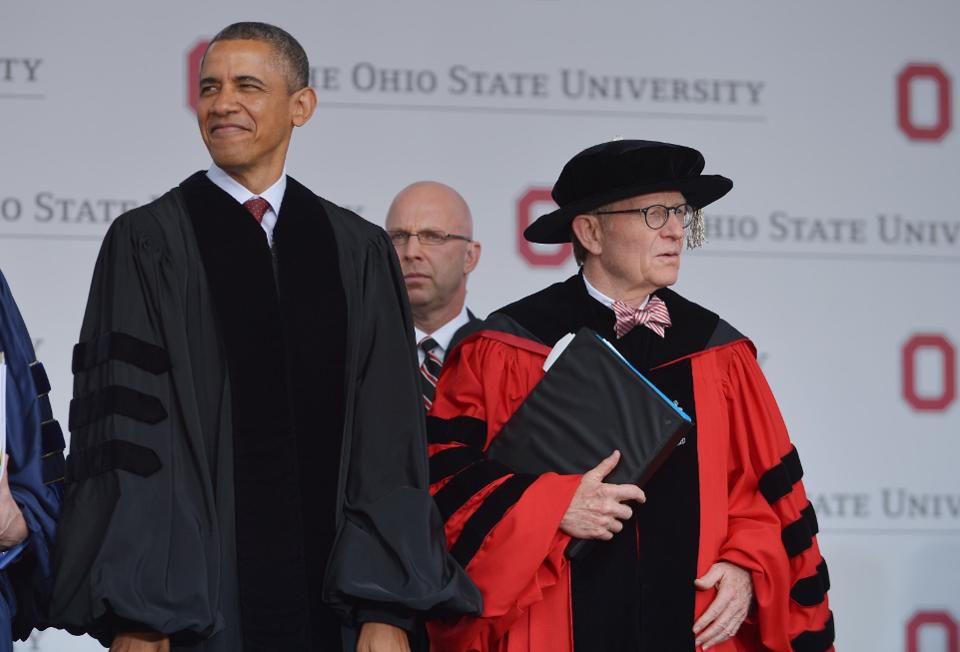
News & Resources
Not All University Presidents are Risk-Averse and Boring

America’s most successful business leaders have included such larger than life personalities as Sam Walton, Steve Jobs, Jeff Bezos and Elon Musk, all individuals who vastly succeeded in achieving big profits, high stock prices, great wealth. Contrast that to the leaders of higher education. Most of them are smart and articulate, but also extremely cautious, not terribly innovative and, frankly, a bit boring. The lack of a well-delineated bottom line (profits) and the reduced incentives associated with that perhaps shapes their vocational persona.
There are, however, some exceptions, individuals who are bold, who take some risks, and who make a mark on higher education. Here are four of them:
Gordon Gee
Gordon Gee could succeed selling ice cream in Alaska in January. He has an infectious, funny, charismatic personality and is a formidable fundraiser. At 73, he is in his 37th year as a university president, having run three flagship state universities in West Virginia, Colorado and Ohio, as well as two prestigious private schools (Brown and Vanderbilt). In many ways, Gee is the quintessential modern successful president, adept at gathering resources and spending them liberally to garner prestige for his institution. He is not the guy to cut costs, rein in ambitions and impose austerity. A page one Wall Street Journal story once revealed his entertainment budget at Vanderbilt was about $600,000 annually. He, however, can be highly innovative. He entered into a long-term lease of Ohio State’s parking garages in return for hundreds of millions of dollars added to the endowment, reasoning that Ohio State was in the education business, not parking. At Vanderbilt, he proposed putting the athletic operation under academic control in the provost’s office (where most academics believe it belongs), saying, “if I tried to do this at Ohio State, I would be pumping gas for a living today.” On every campus, Gee has interacted with virtually every important student, faculty and alumni group. He is indefatigable in using his presence to enliven and unify the campus.
Mitch Daniels
Mitch Daniels is in his sixth year as Purdue University’s president. He is the anti-Gee. While he has a pleasant personality and is good with audiences, he is not a backslapping money-raiser. He has shown that good leadership can bring some efficiency to higher education, perhaps drawing on his extraordinary career as a top business executive, as the director of the Office of Management and Budget, and as governor of Indiana. Daniels is not afraid to buck conventional wisdom, for example by freezing tuition fees for seven years, or by investing university money in its own students through innovative income share agreements. Moreover, he is a kind, sensitive guy: Once, while eating breakfast with me at a posh Washington hotel, he got up to bus the table when finished eating, to relieve the burden on the waiter. Not many university presidents will do that.
Paul LeBlanc
Nearly 15 years ago, Paul LeBlanc became president of a relatively small and young (it began offering degrees in the 1960s) college, Southern New Hampshire University. Since then, enrollment has grown about 35 fold (to around 90,000), and the school operates one of the largest online programs in the country. LeBlanc was committed to offering “No Frills U,” with low-cost but decent-quality schooling for large numbers, which now boasts a $10,000 online bachelor’s degree. Because of its explosive recent growth, the jury is still out as to whether the rapidly growing school delivers in terms of enhancing the lives of its students, but LeBlanc is moving far beyond the traditional model, even as SNHU’s brick and mortar campus enrolls more students than when LeBlanc began.
Michael Crow
For nearly 16 years, Michael Crow has led Arizona State, watching the school’s enrollment soar by about 50% and its national visibility expand. Crow has challenged the traditional academic culture, straining “shared governance” by overcoming obstacles as he introduced all sorts of innovative initiatives. Particularly notable is the agreement he reached with Starbucks enabling its employees to earn a bachelor's degree online through ASU. Like LeBlanc, Crow has pushed online education aggressively. The one question deserving scrutiny relates to the quality of the learning experience.
In spite of the lack of extraordinary financial incentives and given the temptation to play it safe and follow academic norms, there are some who excel in leadership. Hopefully, the example of these and other unnamed innovators will help all of higher education meet the challenges of stagnant enrollment, excessive costs, and declining public support.